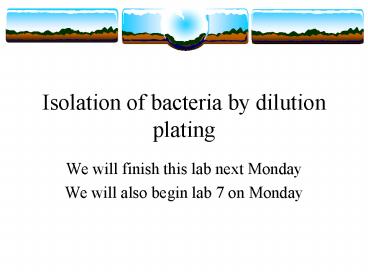Isolation of bacteria by dilution plating - PowerPoint PPT Presentation
1 / 21
Title:
Isolation of bacteria by dilution plating
Description:
Read at the bottom of the meniscus. Press bottom button dispense ... Bottom of meniscus. http://www.rlc.dcccd.edu/mathsci/reynolds/micro/lab_manual/pipet_dilut.html ... – PowerPoint PPT presentation
Number of Views:1926
Avg rating:5.0/5.0
Title: Isolation of bacteria by dilution plating
1
Isolation of bacteria by dilution plating
- We will finish this lab next Monday
- We will also begin lab 7 on Monday
2
Pure vs mixed culture
- Pure originate from 1 bacteria strain
- All colonies look the same
- Mixed originate from many bacteria strains
- Colonies have different size/shape
http//smccd.net/accounts/case/biol240/streakplate
.html
3
Streak plate technique
- Spread millions of cells over the surface
- Individual cells deposited at a distance from all
others - Divide forming distinct colonies
- Distinct colonies do not touch any other colonies
- Clone of a single bacteria ? pure culture
4
- Disinfect your bench, wash your hands and wear
gloves - Label the bottom of a TSA plate
- TSA Tryptic Soy agar (general high nutrient
media) - Keep lid closed when the plate is not in use
- You streak the plate on 3 different portion
- You can draw the section that you will streak on
the bottom of your plate
5
Objective 1 Streak plate
http//www.rlc.dcccd.edu/MATHSCI/reynolds/MICRO/la
b_manual/streakplate3.jpg
6
Streak plate
- Using a sterile loop take a loopful of your
bacteria from the broth - Streak a vertical line
- Then streak gently across section 1
- Zig-zag pattern until a 1/3 of the plate is
covered - Do not dig into the agar
http//www.rlc.dcccd.edu/MATHSCI/reynolds/MICRO/la
b_manual/streakplate2.jpg
7
Streak plate
- Sterilize the loop ? let it cool
- Rotate the plate about 90 degrees and spread the
bacteria from the first streak into a second area - Do only one streak (or very few) in the first
area and once you are in the second area do not
go back to the first - Do a zig-zag pattern until the 2nd area is
covered - Sterilize again ? do the same for 3rd area
8
First section
third section
Sterilize loop, let it cool
Sterilize loop, let it cool
second section
9
Sterilized loop
- Make sure that your red hot loop is cool enough
prior to touch the bacteria - After you waited a few seconds
- Stab it into the agar in a position away from
bacteria ? will cool it - If you stab where bacteria are ? production of
aerosol
10
Isolated coloniesColony Forming Units CFU
http//faculty.mc3.edu/jearl/ML/ml-9.htm
http//www.bact.wisc.edu/themicrobialworld/Prop.ac
nes_colonies.jpg
11
Objective 1Next lab (Monday 18th February)
Gram stain
To confirm you have a pure culture
http//faculty.mc3.edu/jearl/ML/ml-9.htm
http//www.bact.wisc.edu/themicrobialworld/Prop.ac
nes_colonies.jpg
12
Objective 2 Spread plate technique and dilutions
- Label four plates for this exercise
- Name, date, dilution
- Pipette 1 ml from the bacteria culture into 99ml
saline 1100 dilution - 0.1 ml of this into your first plate 11000
dilution - Pipette 1ml of your 100 ml dilution of bacteria
in saline and put into a 9 ml tube 11000 - 0.1 ml of this into your 2nd plate 110000
dilution - Pipette 1ml of your 10 ml dilution of bacteria in
saline and put into another 9ml tube 110000 - 0.1 ml of this into your 3rd plate 1 100000
dilution - Pipette 1ml of your 10 ml dilution of bacteria in
saline and put into another 9ml tube 1100000 - 0.1 ml of this into your 4th plate 1 1000000
dilution
13
Dilution
33
11000
110000
1100000
11,000000
http//www.rlc.dcccd.edu/MATHSCI/reynolds/MICRO/la
b_manual/dilution.jpg
14
Pipetting
- Place the end of the pipette into the opening
pump - Place the pipette tip into the solution
- Press top button ? aspire
- Read at the bottom of the meniscus
- Press bottom button ? dispense
Bottom of meniscus
Pipette tip
http//www.rlc.dcccd.edu/mathsci/reynolds/micro/la
b_manual/pipet_dilut.html
http//www.lab-services.nl/images/cellmate.gif
15
Pipette other considerations
- Always change pipette when going from a more
concentrated solution to a less concentrated
solution ? avoid carry over - Dilution are additive
- 110 dilution is 1 ml into 9 ml, not 1 ml into 10
(that will be a 111 dilution) - Mix well (pipette up and down or swirl gently) ?
prior to take your sample for your dilution
16
Spread plate technique
- Quantitative technique that allows the
determination of the number of bacteria in a
sample. - Pipette the required amount of bacteria (from
your dilution) on the surface of the Petri plate - Spread the inoculum over the surface of the agar
medium using a hockey stick - Incubate the plate inverted at 37oC
http//www.woodrow.org/teachers/bi/1999/projects/g
roup5/gfx/flaming_stick.jpg
17
http//www.bact.wisc.edu/Microtextbook/images/book
_3/chapter_10/10-4.jpg
18
Counting colonies (1Next lab (Monday 18th
February)
- Count by looking at the bottom of the plate
(while keeping the Petri plate closed) - Agar is translucent you should not have to open
the plate - If there are a lot of colonies on the plate ?
helpful to use a marker to mark the colonies
already counted - If there are tons of colonies ?TMTC (Too many to
count)
19
Counting bacteria
- We must have between 30 and 300 colonies on the
plate - Less than 30 might not be representative
- More than 300 very difficult to count
- Also we might not have isolated colonies
20
CFU
- Colonies forming units
- Not the same as bacteria
- 2 bacteria might have been very close and formed
one colony - CFU per ml of sample number of colonies /
(amount plated X dilution)
21
CFU calculation example
- You count 46 colonies on your plate
- You put 1 ml of bacterial culture into 99 ml of
saline and plated 0.1 ml - Dilution 1/100
- CFU 46
- 1/100 0.1
- 46 100 10 46 000
- Dividing by 1/100 is the same as multiplying by
100 0.1 1/10 Do not take amount plated in
consideration twice































